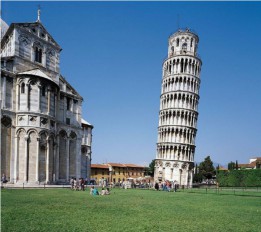How does the Leaning Tower of Pisa survive earthquakes

Despite the hazardous inclination of approximately five degrees, the Leaning Tower of Pisa (in Italy) has managed to survive four strong earthquakes since 1200 A.D.
The construction of the Tower began in 1173 and was completed in 1372. Inclination to the north side was detected from the beginning of the project. However, by the next 100 years the building had shifted to the south. The differential subsidence of the ground lead to an offset of 5 meters at the top of the -58 meters height- tower.
The leaning of Pisa tower is a result deriving from the foundation soil. Clay and sand formations alternate down to almost 70 meters while the foundation depth is less than 3 meters. Nevertheless, the most significant hazard for the tower is the earthquakes that occur systematically in the region. Considering the sensitivity of the construction, a seismic event was expected to cause serious damage to the building. Until today, the response of the tower has proved the expectations wrong.
To investigate this phenomenon, a team of 16 engineers from the UK and Italy was founded. After expended research, the scientists concluded that the survival of the building is attributed to the beneficial interaction of the construction and the soil beneath. The stiffness of the tower combined with the softness of the foundation ground causes the characteristics of a seismic vibration to be mitigated. This effect of the Dynamic Soil-Structure Interaction (DSSI) functions in such a way that the tower does not resonate with the ground motion and therefore the forces acting on the structural elements of the construction are diminished.
Professor Mylonakis, Chair in Geotechnics and Soil-Structure Interaction, and Head of Earthquake and Geotechnical Engineering Research Group in the Department of Civil Engineering at the University of Bristol, states: "Ironically, the very same soil that caused the leaning instability and brought the Tower to the verge of collapse, can be credited for helping it survive these seismic events."
Furthermore, results from the study will be formally announced at the 16th European Conference in Earthquake Engineering in Thessaloniki, Greece next month (18 to 21 June).
Sources: Popular Mechanics, The Times of India
Nearby News
Want to read more like this story?

Leaning tower of Pisa has become slightly straighter
Dec, 07, 2018 | NewsThe leaning tower of Pisa, located in Italy, is now stable and according to a recent report, its til...

The leaning tower of Bologna closes amid settlement concerns
Oct, 21, 2023 | NewsBologna’s leaning 48-meter tall Garisenda Tower was closed during the weekend, after worrying movem...

Tower of Pisa losing its tilt
Nov, 01, 2013 | NewsAccording to an annual report on the monument’s stability, the leaning Tower of Pisa has straightene...

Worsening condition of Bologna’s “leaning tower” to require €20 million restoration work
Dec, 12, 2023 | NewsThings for Bologna’s leaning Garisenda Tower appear to have taken a turn for the worse, according t...

A Tribute to Michele Jamiolkowski
Feb, 25, 2024 | NewsThe “savior of the Leaning Tower of Pisa” February 27, 1964. Diagnosing that the Leaning Tower of...

Video: Building under construction in South Korea tilts 5 times more than the tower of Pisa
May, 19, 2014 | NewsA seven-storey building under construction in the city of Asan, in South Korea tilted unexpectedly b...

San Francisco’s troubled Millennium Tower continues to sink
May, 19, 2022 | NewsThe iconic 58-storey residential building known as Millennium Tower at the city of San Francisco co...

March 31st: The Eiffel Tower was inaugurated, Sir Isaac Newton died, René Descartes was born, and our brand-new Civil Engineering “on this day calendar” is launched
Mar, 31, 2023 | NewsDid you know that the construction of the Eiffel Tower began in January 1887, and it took just over...
Geotechnical Earthquake Engineering
Apr, 21, 2020 | Education
On This Day
April 17th 2019
READ MORE
Trending

How does the Leaning Tower of Pisa survive earthquakes

Strongest earthquake in 25 years rattles Taiwan

China's Three Gorges Dam under pressure: Flood hazard downstream

GEO5 2024 - New Edition released!

Underground tunnel and Yonge Station project in downtown Toronto

Rockfall Mitigation Project in West Virginia


